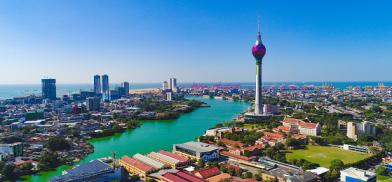Sri Lanka will come out of its present crisis stronger
With heightened external geopolitical fissures in the region, balancing infrastructure diplomacy between China, India and the US is indeed a daunting challenge for Sri Lanka, writes Sugeeswara Senadhira for South Asia Monitor

Together with several other Asian countries under colonial yoke, Sri Lanka attained independence within years of the end of World War II. When the subcontinent giant India got independence on August 15, 1947, the country was partitioned and Pakistan became an independent nation. Four months later, on January 4, 1948, Burma (Myanmar) became free and a month later it was the turn of Sri Lanka, then known as Ceylon.
Sri Lanka’s independence did not come on a platter, as some historians try to project. It was a result of long-drawn freedom struggle commencing with the 1818 and 1848 rebellions and island-wide protests after the 1915 arrests of Sinhala and Tamil patriotic leaders that continued even after the declaration of martial law and detention of leaders during WWII.
In contrast to many other colonies, Sri Lanka was a comparatively small, stable and well-governed colony under British rule. Its first democratic election was held in 1931. The Ceylon National Congress cooperated with the British and formed the United National Party (UNP) and ensured a smooth transition of power after emerging victorious in the first general elections held in 1947. After becoming an independent country on February 4, 1948, the UNP government commenced a movement toward economic self-determination while maintaining a defence treaty with the United Kingdom.
Tamil-Sinhala fissures
Although the newly independent nation with multi-ethnic representatives was committed to the principles of a free, democratic and multi-ethnic Sri Lanka, the Tamil community found its share of employment and educational institutions, which was far above its population ratio, was being diminished as the majority Sinhalese (74 percent) resented the Tamils as the community that took jobs and political power away from them.
The 50-50 demand by C. Suntharalingam and the formation of the Federal Party by S.J.V. Chelvanayakam exacerbated ethnic disunity and mistrust. Furthermore, the decision to disenfranchise the Indian-origin Tamil plantation workers weakened the socialist political parties that enjoyed the support of the working class comprising of all ethnicities.
In 1956, S.W.R.D. Bandaranaike, immediately after becoming Prime Minister, declared Sinhala as the official language and later added "reasonable use of Tamil’. It took another decade to add Tamil also as an official language. Bandaranaike took Sri Lanka out of the British defence pact and emphasized on the need to win economic freedom, having won political freedom and sovereignty.
Sirimavo regime
In 1960, Sirimavo Bandaranaike took the next required step by nationalizing British-owned tea plantations. During her government in 1972, Sri Lanka became a republic. The small island nation also played a prominent partner in the Non-Aligned Movement (NAM) of which the summit was held in Colombo in 1976.
The next fundamental transformation was made by President J R Jayewardene, who introduced the 2nd Republican Constitution and Executive Presidency in 1978. His pro-West foreign policy and close ties with Israel and Pakistan to obtain arms during the LTTE conflict made India uneasy.
First New Delhi supported the LTTE militants covertly but later made known its opposition openly by the infamous violation of Sri Lankan airspace. That blatant act forced Jayewardene to enter into the India-Sri Lanka Agreement of 1987, making a domestic problem an international issue.
President Chandrika Bandaranaike Kumaratunga reversed the foreign policy priorities in 1994 and brought the country back to the policy of non-alignment. There was no major change during the period of President Mahinda Rajapaksa and India extended support by providing training facilities and intelligence cooperation to Sri Lanka during the final onslaught against LTTE terrorists.
Gotabaya’s middle path
President Gotabaya Rajapaksa adopted a middle path foreign policy by giving it the face of neutrality. The government hardly wished to get involved in a Sino-Indian or US-China power struggle. However, with heightened external geopolitical fissures in the region, balancing infrastructure diplomacy between China, India and the US is indeed a daunting challenge for Sri Lanka.
The policy of neutrality is a useful tool for maneuvering out of difficulties in foreign relations. This is a good strategy for countries that did not see their future as partners of one or the other regional or global power. It also gives the government the possibility to fence off encroachments from all sides. Hence, a neutrality policy is the most viable and sensible option for Sri Lanka.
The government of President Gotabaya Rajapaksa is faced with severe economic crisis, with debt-ridden financial difficulties, foreign exchange shortage in addition to the Covid-19 pandemic that resulted in a global economic downturn.
Listing out the achievements made in the first year, President Rajapaksa said at the 73rd Independence Day last year: “I request the intelligent public to remember that all of this has been achieved in little over a year, whilst facing the ongoing Covid-19 pandemic that has debilitated the entire world.”
Sri Lanka has the determination as well as the foundation for recovery and growth. This has been acknowledged by top global economists too. World Bank Chief Economist for South Asia Region, Hans Timmer, stated that due to the structural changes that took place in the economy due to the Covid-19 pandemic, Sri Lanka has the opportunity to come out of the crisis stronger in comparison to its South Asian neighbours.
(The writer is Director (International Media), Presidential Secretariat, Colombo. The views expressed are personal)









Post a Comment